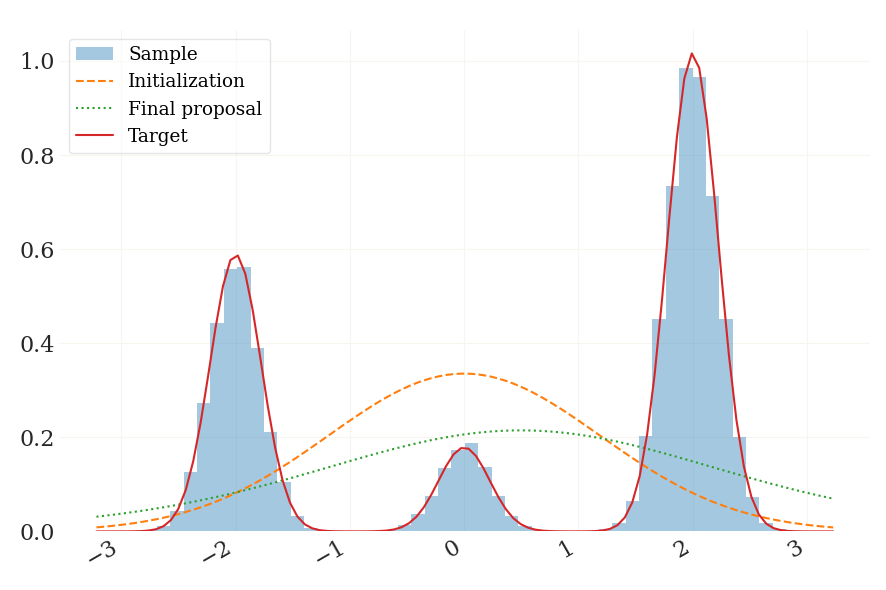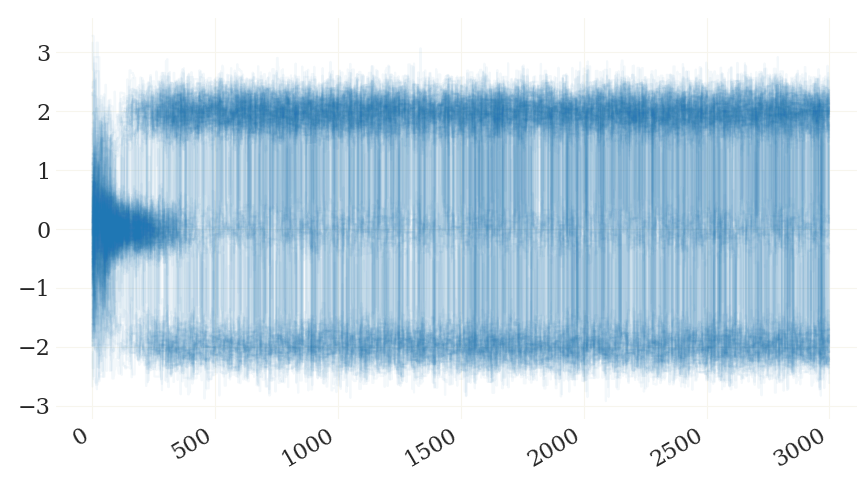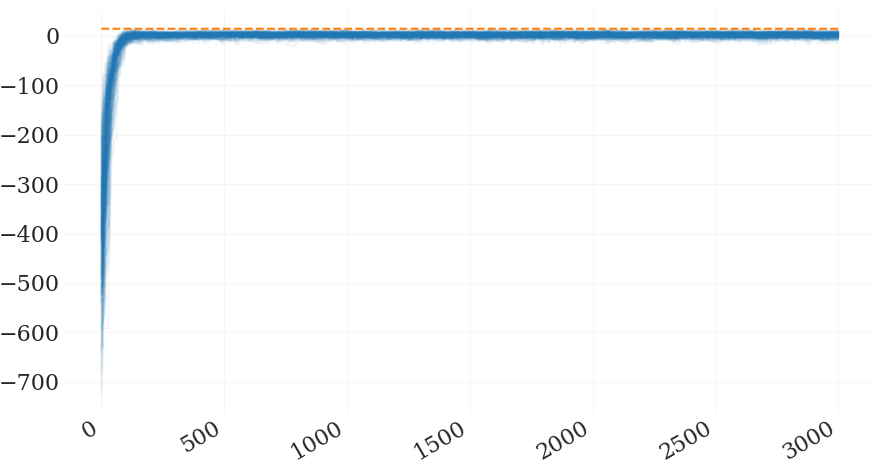Tools for Bayesian inference using Ensemble MCMC
Project description
Collection of tools for Bayesian inference using DIME MCMC sampling
This provides the Differential-Independence Mixture Ensemble (DIME) MCMC sampler together with a nice set of statistical tools for Bayesian analysis. DIME MCMC is developed in Ensemble MCMC Sampling for Robust Bayesian Inference. (Gregor Boehl, 2022, SSRN No. 4250395).
The sampler has a series of advantages over conventional samplers:
DIME MCMC is a (very fast) gradient-free global multi-start optimizer and, at the same time, a MCMC sampler that converges to the posterior distribution. This makes any posterior mode density maximization prior to MCMC sampling superfluous.
The DIME sampler is pretty robust for odd shaped, multimodal distributions.
DIME MCMC is parallelizable: many chains can run in parallel, and the necessary number of draws decreases almost one-to-one with the number of chains.
DIME proposals are generated from an endogenous and adaptive proposal distribution, thereby providing close-to-optimal proposal distributions for black box target distributions without the need for manual fine-tuning.

Figure: A trimodal example distribution in 35 dimensions
Installation
Installing the repository version from PyPi is as simple as typing
pip install emcwrapin your terminal or Anaconda Prompt. There exists complementary stand-alone implementations in Julia language and in matlab.
Usage
The proposal can be used directly as a drop-in replacement for emcee:
import emcee
from emcwrap import DIMEMove
move = DIMEMove()
...
def log_prob(x):
...
# define your density function, the number of chains `nchain` etc...
...
sampler = emcee.EnsembleSampler(nchain, ndim, log_prob, moves=move)
...
# off you go samplingThe rest of the usage is hence analoge to Emcee, see e.g. this tutorial. The parameters specific to the DIMEMove are documented here.
The provided tools for Bayesian analysis are ready-to-use, but largely undocumented. Find the module documentation here: https://emcwrap.readthedocs.io/en/latest/modules.html.
Tutorial
Lets look at an example. Let’s define a nice and challenging distribution (it’s the distribution from the figure above):
# some import
import emcwrap as ew
import numpy as np
import scipy.stats as ss
from emcwrap.test_all import _create_test_func, _marginal_pdf_test_func
# make it reproducible
np.random.seed(0)
# define distribution
m = 2
cov_scale = 0.05
weight = (0.33, .1)
ndim = 35
initvar = np.sqrt(2)
log_prob = _create_test_func(ndim, weight, m, cov_scale)log_prob will now return the log-PDF of a 35-dimensional Gaussian mixture with three separate modes.
Next, define the initial ensemble. In a Bayesian setup, a good initial ensemble would be a sample from the prior distribution. Here, we will go for a sample from a rather flat Gaussian distribution.
# number of chains and number of iterations
nchain = ndim * 5
niter = 5000
# initial ensemble
initmean = np.zeros(ndim)
initcov = np.eye(ndim) * np.sqrt(2)
initchain = ss.multivariate_normal(mean=initmean, cov=initcov).rvs(nchain)Setting the number of parallel chains to 5*ndim is a sane default. For highly irregular distributions with several modes you should use more chains. Very simple distributions can go with less.
Now let the sampler run for 5000 iterations.
# use the DIME proposal
moves = ew.DIMEMove(aimh_prob=0.1, df_proposal_dist=10)
sampler = ew.run_mcmc(log_prob, niter, p0=initchain, moves=moves)[ll/MAF: 11.598(4e+00)/23%]: 100%|████████████████████ 5000/5000 [00:18<00:00, 164.70sample(s)/s]The setting of aimh_prob is the actual default value. For less complex distributions (e.g. distributions closer to Gaussian) a higher value can be chosen, which accelerates burn-in. The information in the progress bar has the structure [ll/MAF: <maximum log-prob>(<standard deviation of log-prob>)/<mean acceptance fraction>]....
Note that if you wish to use emcee directly instead of the wrapper, you could simply do the following, which will give you the same result:
import emcee
sampler = emcee.EnsembleSampler(nchain, ndim, log_prob, moves=moves)
sampler.run_mcmc(initchain, int(niter), progress=True)The following code creates the figure above, which is a plot of the marginal distribution along the first dimension (remember that this actually is a 35-dimensional distribution). For plotting, this tutorial assumes grgrlib to be installed (just run pip install grgrlib in terminal/prompt).
from grgrlib import figurator
# get elements
chain = sampler.get_chain()
lprob = sampler.get_log_prob()
# plotting
figs, axs = figurator(1, 1, 1, figsize=(9,6))
axs[0].hist(chain[-niter//2 :, :, 0].flatten(), bins=50, density=True, alpha=0.2, label="Sample")
xlim = axs[0].get_xlim()
x = np.linspace(xlim[0], xlim[1], 100)
axs[0].plot(x, ss.norm(scale=np.sqrt(initvar)).pdf(x), "--", label="Initialization")
axs[0].plot(x, ss.t(df=10, loc=moves.prop_mean[0], scale=moves.prop_cov[0, 0] ** 0.5).pdf(x), ":", label="Final proposals")
axs[0].plot(x, _marginal_pdf_test_func(x, cov_scale, m, weight), label="Target")
axs[0].legend()To ensure proper mixing, let us also have a look at the MCMC traces, again focussing on the first dimension.
figs, axs = figurator(1, 1, 1)
axs[0].plot(chain[:, :, 0], alpha=0.05, c="C0")
Note how chains are also switching between the three modes because of the global proposal kernel.
While DIME is an MCMC sampler, it can straightforwardly be used as a global optimization routine. To this end, specify some broad starting region (in a non-Bayesian setup there is no prior) and let the sampler run for an extended number of iterations. Finally, assess whether the maximum value per ensemble did not change much in the last few hundred iterations. In a normal Bayesian setup, plotting the associated log-likelihood over time also helps to assess convergence to the posterior distribution.
figs, axs = figurator(1, 1, 1)
axs[0].plot(lprob, alpha=0.05, c="C0")
axs[0].plot(np.arange(niter), np.max(lprob) * np.ones(niter), "--", c="C1")
References
If you are using this software in your research, please cite
@techreport{boehl2022mcmc,
author={Gregor Boehl},
title={Ensemble MCMC Sampling for Robust Bayesian Inference},
journal={Available at SSRN 4250395},
year={2022}
}Project details
Release history Release notifications | RSS feed
Download files
Download the file for your platform. If you're not sure which to choose, learn more about installing packages.











